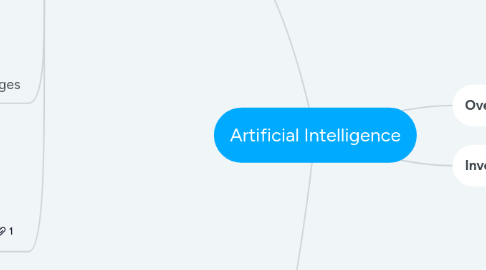
1. Opportunities
1.1. Enhanced Efficiency and Automation
1.1.1. Automating tasks
1.1.2. Improved decision making
1.2. Innovation and New Products
1.2.1. Fuels creativity
1.2.2. Personalizing experiences
1.3. Revolutionizing Industries
1.3.1. Healthcare
1.3.2. Finance
1.3.2.1. Predictions that there will be a lot of wearables and an explosion of content due to generative AI
1.3.3. Transportation
1.3.4. Retail
1.4. Specialized AI Skills and Roles
1.4.1. Machine learning engineers
1.4.2. Data scientists
1.4.3. AI Ethics
1.4.4. AI user experience (UX)
1.5. Addressing Global Challenges
1.5.1. Climate Change
1.5.2. Sustainability
1.5.3. Global Health
1.6. Hype vs Reality
1.6.1. Education
1.6.1.1. Generalized education will be more valuable
1.6.2. Physical AI
1.6.2.1. Humanoid Robots
1.6.2.1.1. Integration is happening vertical by vertical
1.6.2.1.2. 1 billion will be in use by 2040 - Elon Musk
2. Risks
2.1. Ethical
2.1.1. Data bias
2.1.2. Copyright issues
2.2. Geopolitical
2.2.1. Lack of international regulation
2.2.2. Defense technology
2.3. Economic
2.3.1. Job displacement
2.3.1.1. Unemployment
2.3.1.1.1. Automation threat
2.3.1.2. Re-skilling & Up-skilling
2.4. Security
2.4.1. Privacy and disinformation issues
2.4.2. Data collection & use
2.4.3. Security threats
2.4.4. Data regulation
2.5. Programming biases
2.5.1. Algorithmic bias
2.5.1.1. This would affect algorthims that could affect technologies across banks and organizations
2.5.2. Mitigating bias
2.5.2.1. Techniques to identify and then mitigate
2.6. Existential and Super Intelligence
2.6.1. Long-term Concerns
2.6.1.1. Superintelligence: surpassing human control
2.6.2. Safe AI
2.6.2.1. Alignment with human values
2.7. Hype vs Reality
2.7.1. Regulations
2.7.1.1. Regulation can't keep up
2.7.1.2. Risks can grow out of hand
2.7.2. Eduation
2.7.2.1. Generalist will be more valuable than specialist
2.7.2.1.1. Specialized disciplines are at risk
3. Overview
3.1. Feilds
3.1.1. Machine Learning
3.1.1.1. Auto ML
3.1.1.2. Generative AI
3.1.2. Deep Learning
3.1.2.1. Natural Language Processing (NLP)
3.1.2.2. Computer Vision (CV)
3.1.3. Reinforced Learning
3.1.3.1. Robotics
3.1.3.2. Gaming and simulation
3.1.4. Explainable AI (XAI)
3.2. Benefits
3.2.1. Enhanced Efficiency and Productivity
3.2.1.1. Automation
3.2.1.2. Data-driven Decision Making
3.2.2. Innovation and New Products
3.2.2.1. Fueling Creativity
3.2.2.2. Personalized Experiences
3.2.3. Improved Accuracy and Performance
3.2.3.1. Machine Learning
3.2.3.2. Enhanced Automation
3.2.4. Revolutionizing Industries
3.2.4.1. Healthcare
3.2.4.2. Transportation
3.2.4.3. Customer Service
3.3. Major Players
3.3.1. Tech Giants
3.3.1.1. Apple
3.3.1.2. Amazon
3.3.1.3. Google
3.3.1.4. Microsoft
3.3.1.5. Meta
3.3.2. AI Focused
3.3.2.1. OpenAI
3.3.2.2. NVIDIA
3.3.2.3. Palantir
3.3.2.4. IBM
3.3.2.5. Deep Mind
3.4. Industry
3.4.1. Current Size
3.4.1.1. Statista: Pegs the market size at USD 305.90 billion in 2024, with a projected CAGR of 15.83% reaching USD 738.80 billion by 2030.
3.4.1.2. Precedence Research: Estimates the market value at USD 454.12 billion in 2022
3.4.2. Growth
3.4.2.1. Growth projections suggest a significant increase in market size by 2030, ranging from USD 738.8 billion to USD 2,575.16 billion.
3.4.2.2. The CAGR is estimated to be between 15.83% and 19%, indicating a steady and substantial rise.
4. Investment Ideas
4.1. Platforms
4.1.1. Hugging Face
4.1.1.1. Enables AI and vertical AI infrastructures
4.1.2. Health Universe
4.1.2.1. Building a code repository for healthcare AI present opportunity
